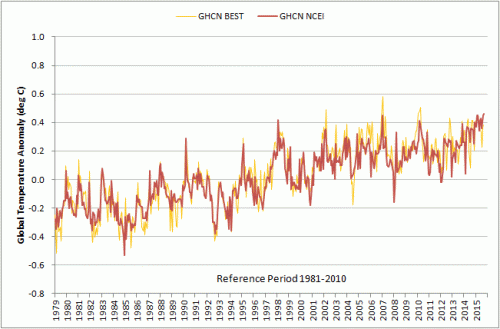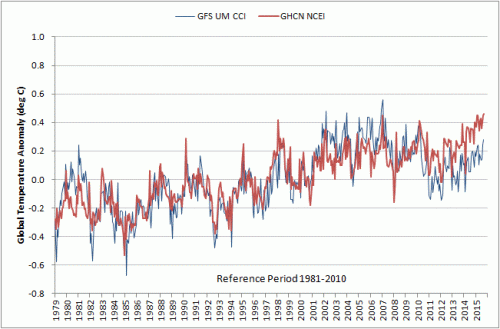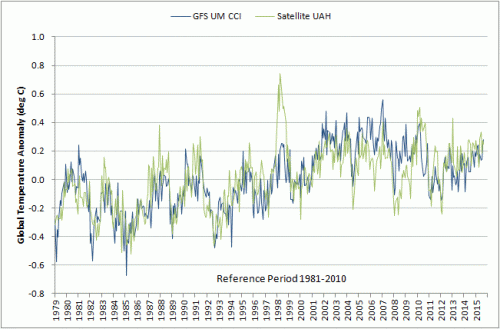It is interesting and instructive to compare different independent estimates of global temperature anomalies. The largest amount of data available for input to global temperature estimates has occurred with the advent of satellite weather surveillance and global weather forecast models in the late 1970’s. Prior to that time, data coverage was much more limited, especially over the oceans that make up about 71% of the earth’s surface. Therefore the older estimates are likely to be less accurate and thus more uncertain. Consequently, this comparison will focus on the period from 1979 to present where we have more data.
There are three main relatively independent sources of global surface temperature anomaly estimates available, derived from: the Global Historical Climate Network (and sometimes including additional land stations) coupled with sea surface temperature measurements (GHCN), global weather forecast model input data, and satellite estimates of lower tropospheric temperatures. There are multiple groups that compile and publish estimates from these sources but for simplicity, estimates from four of these groups are presented here. For the GHCN related estimates, this analysis uses the US National Center for Environmental Information (NCEI) estimates and the Berkeley Earth Surface Temperature (BEST) estimates. These are compared to the satellite estimates from the University of Alabama Huntsville (UAH) and global forecast system (GFS) estimates provided by the University of Maine (UM) Climate Change Institute (CCI).
Monthly global temperature anomaly estimates from all four groups representing three independent sources are presented in Figure 1 for the period 1979 through September 2015 and normalized to the 30-year climatic reference period 1981 through 2010. The most widely publicized of these estimates are from NCEI and are highlighted in bold red. In general, there is a fairly close agreement, typically within plus or minus 0.2 degrees Celsius (C) for most months. The general trend over the entire 37 year period is upward by about 0.4C. The variability between these estimates hints at the uncertainty but does not fully characterize it. My best guess is that the uncertainty of estimates during this period is at least plus or minus 0.3C to 0.5C, as described in more detail here:
Uncertainty in Global Temperature Assessments
Considering the size of the uncertainty compared to the size of the trend, my opinion is that we can only say with low confidence that there may be a small rise in the global temperature during this period.
To allow more direct comparisons, Figures 2 through 5 present estimates for two groups at a time. The GHCN related estimates from BEST and NCEI are compared in Figure 2. As might be expected, these estimates show a striking similarity, although there is a hint of slightly larger monthly variations in the BEST estimates. They both show a very similar trend.
Figure 3 compares the GFS UM CCI estimates with the GHCN NCEI estimates. For most of the period the two estimates are close, with the exception of two periods where the GFS UM CCI estimates are consistently slightly higher for 1980-1981 and 2002-2007 and for the most recent period since about 2010 where the GHCN NCEI estimates have suddenly departed substantially higher than the GFS UM CCI estimates by a fairly constant offset near 0.2C. I am not aware of any major changes in the methodology or data inputs for the GFS UM CCI, but the GHCN NCEI estimates are constantly being revised and adjusted. It appears that recent adjustments may have introduced a substantial high bias since 2010, especially considering that the GFS UM CCI and UAH satellite estimates show a fairly good match during this period.
The UAH satellite estimates show the same general trend as the GHCN NCEI estimates, but a larger monthly variability as shown in Figure 4. Considering that the UAH satellite estimates are for the lower troposphere whereas the GHCN NCEI estimates are for the surface, this comparison is easily within the previously mentioned uncertainty range. This comparison also shows a hint of a possible high bias in the GHCN NCEI estimates since 2010.
The UAH satellite estimates seem to subjectively show a slightly better comparison to the GFS UM CCI estimates as seen in Figure 5 than compared with the GHCN NCEI estimates in Figure 4. The main deviations seem to be associated with El Niño and La Niña events. The UAH satellite estimates are much higher during the very strong 1998 El Niño and slightly higher during weaker El Niños in 1983, 1987, 1991, and 2010 and somewhat lower during the 2007-2008 La Niña period. The UAH satellite and GFS UM CCI estimates show a good agreement since 2010, unlike the suspect GHCN NCEI estimates.
These comparisons give me less confidence in the GHCN NCEI estimates, especially since 2010. My feeling is that the GFS UM CCI estimates, which are based on data with much better spatial coverage than the GHCN related estimates, probably provide the most accurate surface temperature anomaly estimates for this period. In my next post, I will compare the trends in these estimates across the full 37 year period and then in a following post trends for the current century so far 2001-2015.
Monthly global temperature anomaly sources:
NCEI
http://www.ncdc.noaa.gov/cag/time-series/global/globe/land_ocean/p12/12/1880-2015.csv
BEST
http://berkeleyearth.lbl.gov/auto/Global/Land_and_Ocean_complete.txt
UAH
http://vortex.nsstc.uah.edu/data/msu/v6.0beta/tlt/tltglhmam_6.0beta3.txt
UM CCI
http://cci-reanalyzer.org/Reanalysis_monthly/output/tseries_1_0_0_12_0.csv





